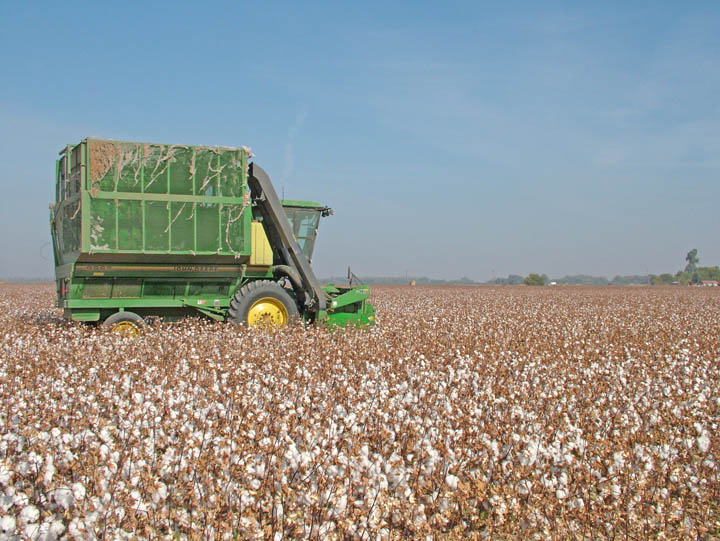
Let’s talk $2 cotton
Pima cotton growers in California, Arizona, New Mexico and Far West Texas are tantalizingly close to a $2 per pound market for Extra Long Staple cotton.The Pima price is so high because mills are scrounging for Pima, and the 2009 U.S. crop is sold out.It will be the latest season ever for Extra Long Staple Pima in the San Joaquin Valley.
October 15, 2010

$1 cotton?
Pshaw!
Pima cotton growers in California, Arizona, New Mexico and Far West Texas are tantalizingly close to a $2 per pound market for Extra Long Staple cotton.
No joke. American Pima cotton prices are unbelievably close to that remarkable number.
At a Phytogen cotton variety update meeting Oct. 13, in Tulare County, Calif., Calcot field representative Kevin Madding said Pima quotes that day were in the $1.80 to $1.90 range.
“We’ll hold out for $2,” joked one grower, mimicking the ancient tale of an upland farmer who was urged to sell after prices hit the 90-cent range. Despite the temptation, he decided to hold out on selling until prices hit $1 per pound. The story goes; they never did.
The $2 jokester drew a lot of laughs from fellow growers in Tulare.
As everyone knows, short staple hit $1 on the future market earlier this fall. It continues to hover around it. On the day of the meeting in Tulare, Madding said it was $1.11 per pound on the futures.
San Joaquin Valley Acala growers would get more than that because of the traditional “on basis” for the longer, stronger fiber of SJV Acala. If it is roller ginned rather than saw ginned, it could bring even more per pound … maybe an additional 10 cents per pound more. Add it all up, and SJV Acala could bring $1.25 or more in this breathtaking year for American cotton producers. Also, roller ginned Acala generally has a higher turnout than saw ginned Acala.
All of this blue sky price talk is just that — talk — for now. It is likely that Pima growers contracted for at least a portion their crop during the price run-up. Questions remain: Did the growers sell it all and just how much cotton would be available if and when the $2 bell is rung?
The Pima price is so high because mills are scrounging for Pima, and the 2009 U.S. crop is sold out. There is none available to keep mills running, and they have textile orders to meet.
Supima’s office in Phoenix is getting calls often and repeatedly from mills asking when the first 2010 bales will be available.
Late SJV season
The answer from the growers at the Tulare meeting is that it will be late — the latest season ever for Extra Long Staple Pima in the San Joaquin Valley. Many Pima fields had not been defoliated by mid-October. The fall weather has been semi-cooperative with warm days, but nights have been very cool. Some defoliants stop working at 60 degrees. The cool weather is hampering Acala/upland defoliations. Tulare County University of California Cooperative Extension Farm Advisor Steve Wright said that he has noticed desiccated leaves are sticking to the plant and not dropping off. This would make picking and ginning challenging for both Pima and Acala.
That and the lateness of the season with the threat of fog and wet weather growing daily are huge hurdles for anyone wanting to get $2 for cotton because it has to get into the bale in excellent quality condition to earn coffee shop bragging rights.
Making the price even more tantalizing is that there may be more Pima in the fields than most thought. That is certainly the case with the Acala uplands which have opened. Many fields are loaded in Tulare County.
There was one report from an Acala grower who had started picking, expecting 2.5 bales per acre. He was putting more than 3 bales into the modules.
“I think everyone will be surprised at yields this year. I think they will be better than most think,” said one of the largest growers in the Valley.
Although the start was miserable because of cool, wet spring planting weather, the summer was mild. There were no long, hot spells to stop cotton set.
San Joaquin Valley growers grow more than 90 percent of the Pima produced in the U.S. cotton belt. The rest is grown in Arizona, New Mexico and Far West Texas.
It is good to hear the buzz about the comeback of cotton in California, but growers are fully aware that it is a long way to harvest.
2011 Pima prices
While 2010 is in the headlights, 2011 is really not that far away. Price quotes are already floating around for Pima for 2011. One grower said he has been offered $1.25 per pound for 2011 Pima, seven or eight months before it is planted.
$1 and now $2 cotton are the brass rings in farming, and many growers said there are people looking to rent land to grow Pima next season due to the current prices. Many former growers still have cotton equipment and are ready to jump back in. Everyone wants to grow Pima, and many continue to try it for the first time.
East of Tulare and just a few miles to the west, Pima does not do well. It is best suited to soil conditions on the far West Side of the San Joaquin Valley.
“Several growers have struggled with Pima this year — over watering it for one thing,” said Phytogen’s Harry Peck, Central Valley Dow AgroSciences representative. “I have walked more cotton fields than I have in a long time for growers who were seeing problems.” Most of those strolls came early as growers grew anxious about slow emerging cotton. Also new Pima growers become concerned about the amount of white they see. Peck has to remind them that Pima bolls are smaller; there are twice as many Pima bolls as Acala bolls on the plant.
Phytogen sells more than 80 percent of the Acala and Pima cotton planting seed in the San Joaquin Valley. “Growers on the West Side of the Valley do a great job with Pima. That is not the case as you move to the east.”
Nevertheless, Pima continues to reach into areas not historically well suited for it, primarily because of a shorter growing season. The northern San Joaquin Valley is one of those areas. Growers there have long wanted to grow Pima. Phytogen has provided a shorter season Pima for that area and there is more of it this season.
“A lot of growers are banking on Pima this season in the northern end of the Valley,” said Dow’s Nick Higgins, who covers that area.
Merced County has been one of the highest cotton producing Acala/Upland counties in the Valley for several years. North Valley growers expect to be challenged at harvest by the weather and typically start early with defoliation.
“We typically defoliate about the same time as Kern County growers. Not this year,” said Higgins. “It is going to be a challenging and maybe a make-or-break year for Pima in the north Valley. It all depends on what kind of weather we get from here on out.”
Regardless of what happens this season, there will be more cotton planted in California next season. Peck said it would not be surprising to see it reach 400,000 acres from the 303,000 this season.
However, cotton will be economically challenged by high wheat and corn prices right now, both price benefactors from Russia’s pullout of the world wheat market.
Pima is expected to remain particularly strong through 2011. This will bolster Phytogen’s Pima breeding efforts, according to chief Phytogen cotton breeder Joel Mahill. He said the company has promising new Roundup Flex varieties as well as newer, earlier Pima germplasm.
Tulare County grower Mark Watte reminded Mahill that just went of Tulare is Acala country and advised that Phytogen not forget that market.
Mahill admitted Phytogen scaled back its Acala breeding efforts about two years ago with the decline in California cotton acreage, but Mahill has been “stoking the fire” to ramp up the Acala breeding program.
About the Author(s)
You May Also Like





